Where To See Sloths In Costa Rica + Spotting Tips!
Costa Rica is a wildlife haven and possibly the best place in the world to see sloths in their natural habitat. Native to Central and South America, sloths are notoriously hard to spot; without knowing the best places to see sloths in Costa Rica, you could miss them.
Seeing sloths is one best things to do in Costa Rica and it was one of the reasons we took a family trip to Central America. Despite reports, they are spotted everywhere; unless you know where to see sloths in Costa Rica, your chances of spotting them are slim. Most of the sloths we saw were pointed out to us.
Top locations to spot sloths in Costa Rica: Manuel Antonio National Park, Tortuguero National Park, Arenal Volcano National Park, Monteverde Cloud Forest Reserve
The Best Place To See Sloths In Costa Rica
The vast primary rainforests of Costa Rica are home to both the two-toed and the three-toed sloth. Although rainforests are the best place to see sloths in the wild, spotting them can be difficult as they move slowly, high up in the tree canopies.
We recommend enlisting an experienced guide to give you the best chance of spotting them. It is well worth the expense as a good guide will also spot other wildlife and interesting fauna, which you might otherwise walk by.
You will not find sloths living in the Guanacaste on the North Pacific Coast as the tropical forest is too dry. National parks and sloth sanctuaries are the best places to see sloths in Costa Rica:
Where To See Sloths: National Parks and Reserves
1 | Manuel Antonio National Park
The tropical paradise of Manuel Antonio National Park is located on the Pacific coast. Home to both two-toed and three-toed sloths, this park offers the opportunity to observe sloths in their natural habitat.
We took a guided tour along the ‘sloth trail’. The guide pointed out sloths high in the canopy that we would not have spotted. As the national park is small, you might be lucky to continue finding sloths yourself once you know what to look for. If you don’t spot a sloth, you will definitely see lots of monkeys.
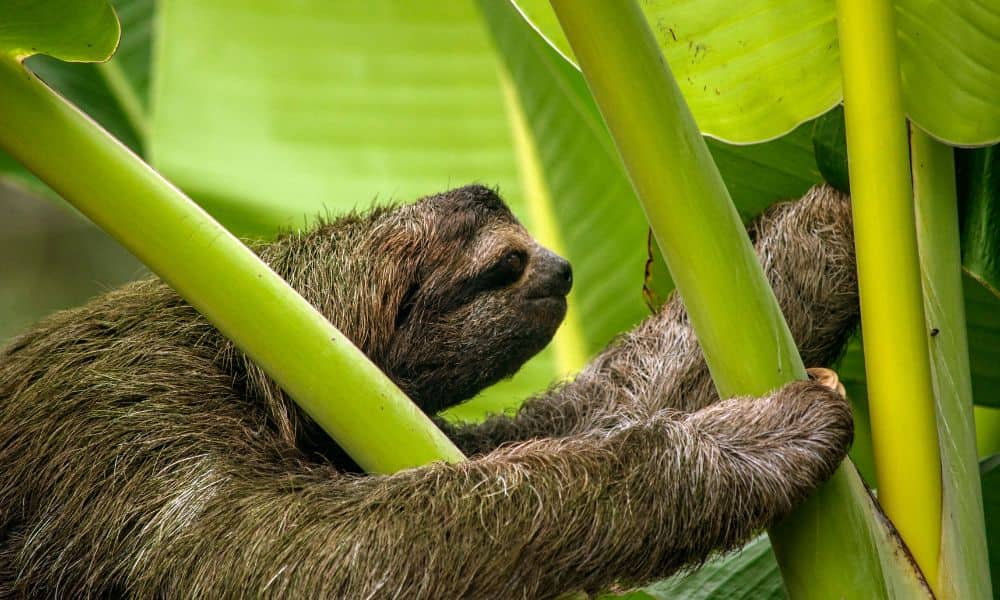
2 | Tortuguero National Park
Known for its rich biodiversity, Tortuguero National Park is another hotspot for sloth sightings. Accessible only by boat or plane, the park’s dense network of canals is teeming with wildlife, including sloths, as this is a pristine example of their natural habitat.
While we didn’t see any sloths on our visit, as it was raining! Other tourists had seen sloths the day before. We did see some massive iguanas and nesting turtles.
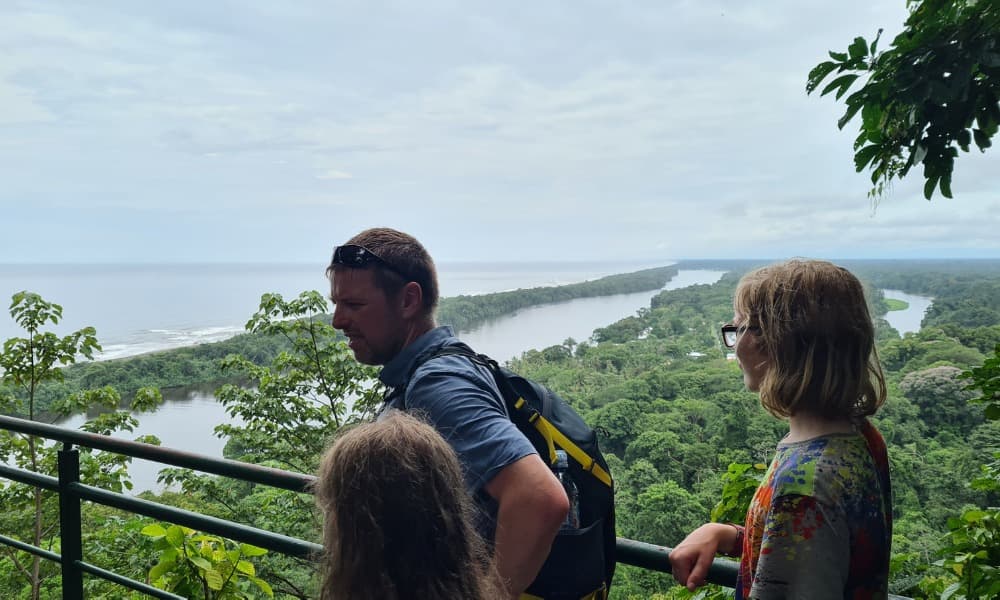
3 | Arenal Volcano National Park
For an unforgettable sloth-spotting experience, visit the Arenal National Park. Its unique volcanic ecosystems provide the ideal environment for sloths to thrive. Keep an eye on the treetops and you may be rewarded with a sighting of these slow-moving marvels against the backdrop of the majestic Arenal Volcano.
Despite being fairly urban, we spotted several sloths in nearby La Fortuna, proving that it is always worth keeping your eyes peeled!
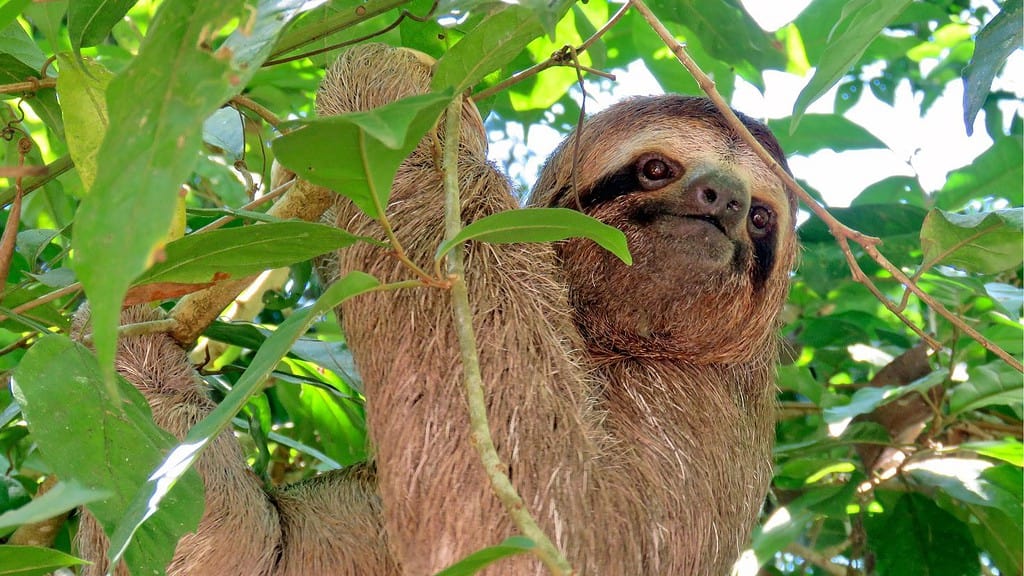
4 | Monteverde Cloud Forest Reserve
Our search for sloths in the wild took us to the mystical Monteverde Cloud Forest Reserve, an eco-paradise situated high up in the mountains. Only the two-toed sloths inhabit this area as it is cooler at the higher elevations.
We explored the cloud forest’s canopy bridges and trails, encountering a wide variety of wildlife, including a sloth hanging lazily in the trees and squawking scarlet Macaws. The reserve’s unique environment makes it a prime location for a memorable sloth encounter.
Where To See Sloths: Sloth Sanctuaries in Costa Rica
5 | Sloth Sanctuary – Cahuita
Situated on the Caribbean coast of Costa Rica, Cahuita is home to the Sloth Sanctuary. This dedicated facility rescues and rehabilitates injured or orphaned sloths to release them back into the wild.
You can take a guided tour to learn about their conservation efforts and get up close to these adorable animals. It’s a heartwarming experience for the entire family.
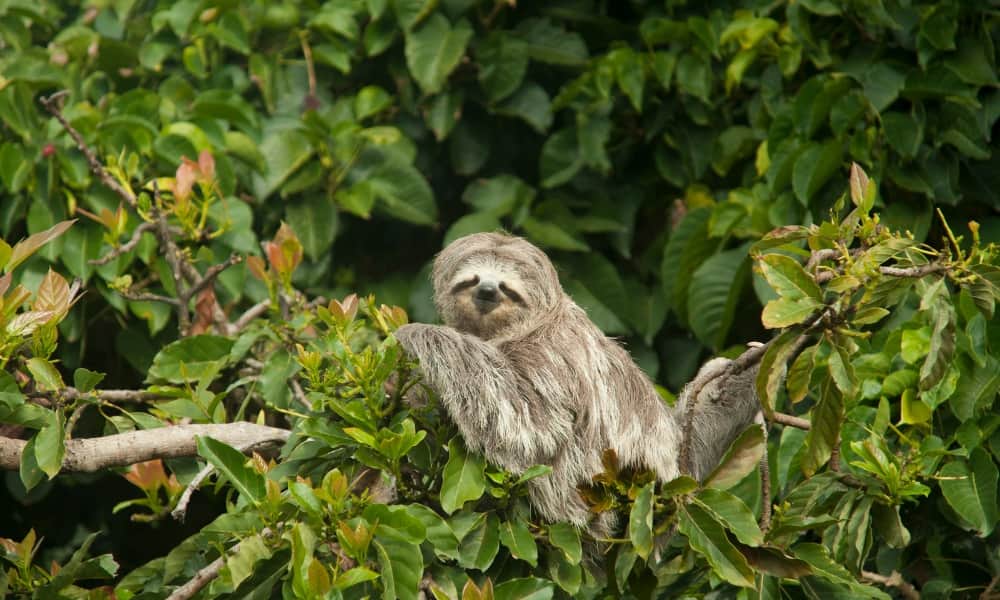
6 | Jaguar Rescue Center
Yes, you have read it correctly! The Jaguar Rescue Center near Punta Cocles on the Caribbean Coast is a top pick for spotting sloths. Amongst the many other animals they receive, they take in over 300 sloths yearly to rehabilitate them back to full health before releasing them back into the wild.
The Center can provide a permanent, safe home to animals not released in their on-site sanctuary, which closely mimics the wild.
7 | The Sloth Sanctuary At Selvatura
Selvatura Park is a purpose-built sanctuary designed to feel as close to the sloth’s natural habitat. Safe from predators, the sloths are relatively easy to spot amongst the tree tops whilst you remain a respectful distance away to prevent stress.
They have around 20 sloths, all having been rescued from habitat destruction, illness and accidents. Whereas some were left orphaned due to illegal hunting, but the one thing they have in common is that, sadly, none of them can be returned to the wild.
8 | Diamante’s Animal Sanctuary
Diamante Animal Sanctuary is one of the largest in Costa Rica and has many species, including monkeys, jaguars, pumas, frogs, toucans, reptiles and sloths! There is also a world class butterfly observatory where you and your kids can learn about their lifecycle and how important butterflies are to the rainforests and moths to sloths.
Please note: it is illegal to hold sloths in Costa Rica, even in a sanctuary.
Different Types Of Sloth In Costa Rica
Whilst all sloths may look similar to the untrained eye, there are, in fact, six species of sloth, all of which are found in the Americas. The six species fall into two family groups of the Bradypodidae and the Choloepus.
| Bradypodidae | Choloepus |
| Brown-throated three-toed sloth* | Hoffman’s two-toed sloth* |
| Pygmy three-toed sloth | Linnaeus’s two-toed sloth |
| Maned three-toed sloth | |
| Pale-throated sloth |
Only two of these species inhabit the rainforests of Costa Rica and can be distinguished from each other by their colouration and the number of toes on their front legs.
Costa Ricas most commonly spotted sloth is the brown-throated three-toed sloth, which is named after its distinctive brown neck. It is about the size of a domestic cat and has black markings around its eyes.
The Hoffman’s two-toed sloth is slightly larger with pale fur around its neck. It also has one less toe on its front leg, hence its name.
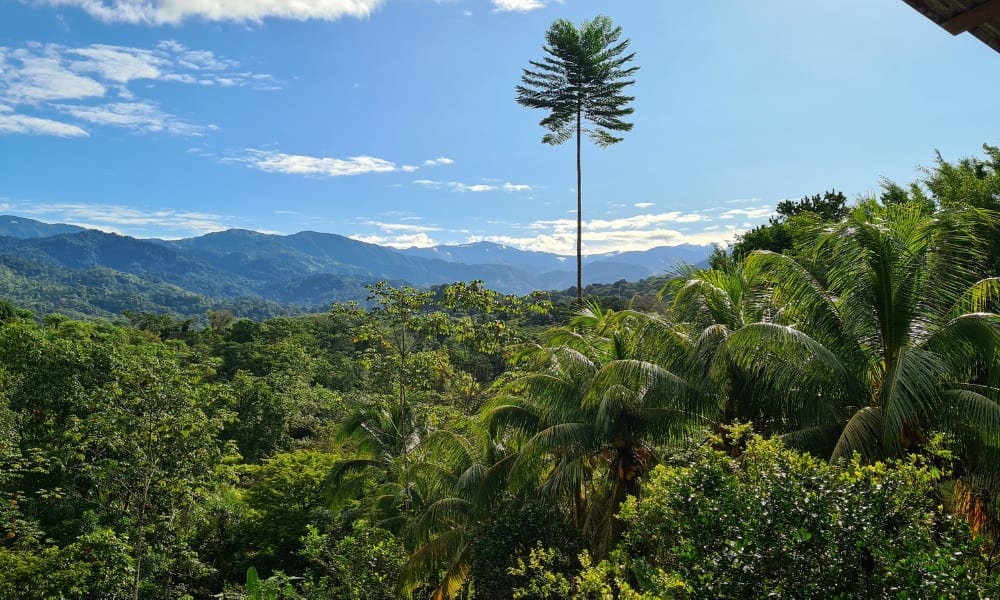
The Best Time To See Sloths In Costa Rica
The best time to see sloths in Costa Rica depends on the region you are visiting and the particular species of sloth you hope to encounter.
Two-toed sloths are nocturnal, meaning they are most active during the night or twilight hours, while three-toed sloths are Diurnal, sleeping at night and grazing slowly through the day. Three-toed sloths are not found in the cooler, higher altitude regions like Monteverde.
Generally, the dry season (December to April) is considered the best time to visit Costa Rica and is excellent for sloth sightings. Due to reduced rainfall, sloths find it easier to move around to find food, increasing your chance of spotting them. Trails also tend to be clearer in the dry season and the more pleasant weather can enhance your overall wildlife-watching experience.
On the other hand, the wet season (May to November) brings lush, vibrant green vegetation. While spotting sloths during heavy rain may be more challenging, the wet season showcases the rainforests at their best.
Some regions, such as Tortuguero and La Fortuna, boast thriving populations of sloths year-round, making them potential sloth-spotting destinations regardless of the specific time of year.
Facts About Sloths: Costa Rica
Despite their slow pace of life, there is a lot to get excited about sloths! Here are some of the amazing facts that make sloths so fascinating:
- All sloth species have three toes on their hind-limbs. The real difference in digits is in their forelimbs, with sloths in the Choloepus family having two fingers, and sloths in the Bradypodidae family having three.
- Sloths are excellent swimmers! They actively swim across bodies of water, searching for new territory or potential mates. They travel up to 3 x faster in the water than they do in trees!
- They have four chambers in their stomach that allow them to extract the maximum nutrition from their extremely low-calorie diet, which primarily consists of leaves, but they also eat insects, lizards, fruit, and eggs.
- Sloths digest their food extremely slowly, taking up to 30 days to process each meal.
- Their fur is its own ecosystem! Each sloth can host many organisms, including beetles, moths, microbes, fungi and green algae. The algae have a symbiotic relationship with the sloth, providing a dietary supplement and camouflage.
- Sloths won’t defecate or urinate where they hang. Instead, they make a long, slow trip, once a week, to the bottom of their tree, where they can expel up to a third of their body weight!
- More than half of all sloth deaths occur during their toilet trip. This is as a result of them being much more vulnerable to predators while they are on the ground without the speed to escape.
- Today’s sloths are tiny compared to their ground-dwelling, elephant-sized ancestors who roamed the earth up until 10,000 years ago. The ancestors are also the reason avocados are so widely spread across South America. They are almost solely responsible for its distribution as the seed.
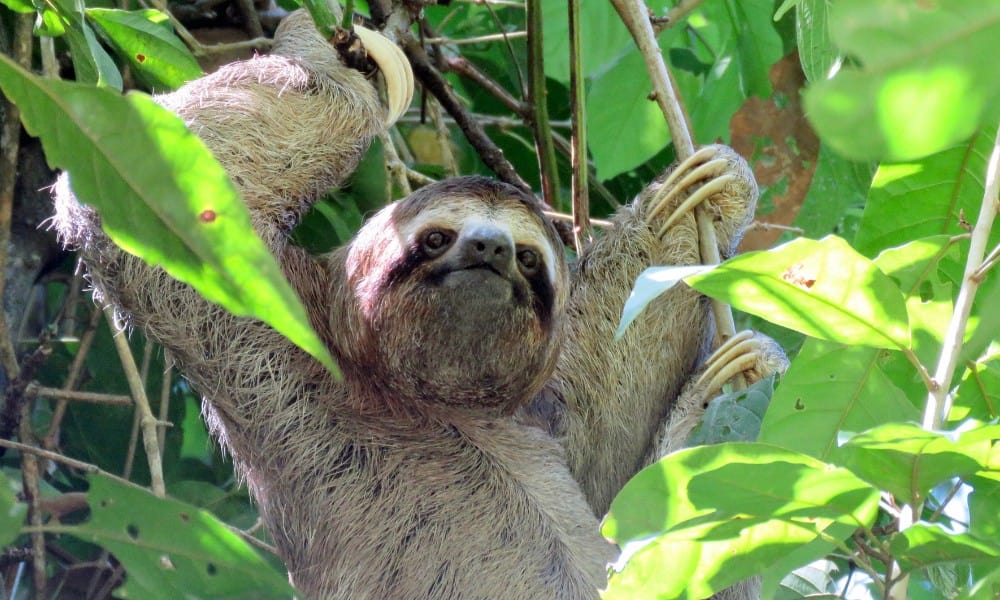
Tips On How To Spot Sloths In Costa Rica
If seeing a sloth is on your bucket list, an experienced guide is essential. When doing your research, make sure they are certified and can show their “Institute of Costa Rica Tourism card”.
Learning what Cecropia, Clethraceae and Clusiaceae trees look like will help you identify the trees you should be searching to find a sloth. Observation during dawn and dusk is most effective as sloths are more active before the day gets too hot.
Look up! It might sound obvious but sloths spend the majority of their life hanging in the tree canopies. Sloths move very slowly, and their fur can blend in with the surrounding foliage. Scan the trees methodically, paying attention to any unusual shapes or textures. Use binoculars to look for Clumps of Fur on branches as sloths camouflage with surrounding vegetation.
Try not to make much disturbance and listen for any unusual soft hissing or growl sounds that might indicate the presence of a sloth. Observe Tree Movements for subtle changes that might be a sloth changing location. Finally, be Patient, stay still, and observe the surroundings quietly.
If you haven’t seen a sloth in the wild visit a Sloth Sanctuary or Reserve to increase your chances of spotting them.
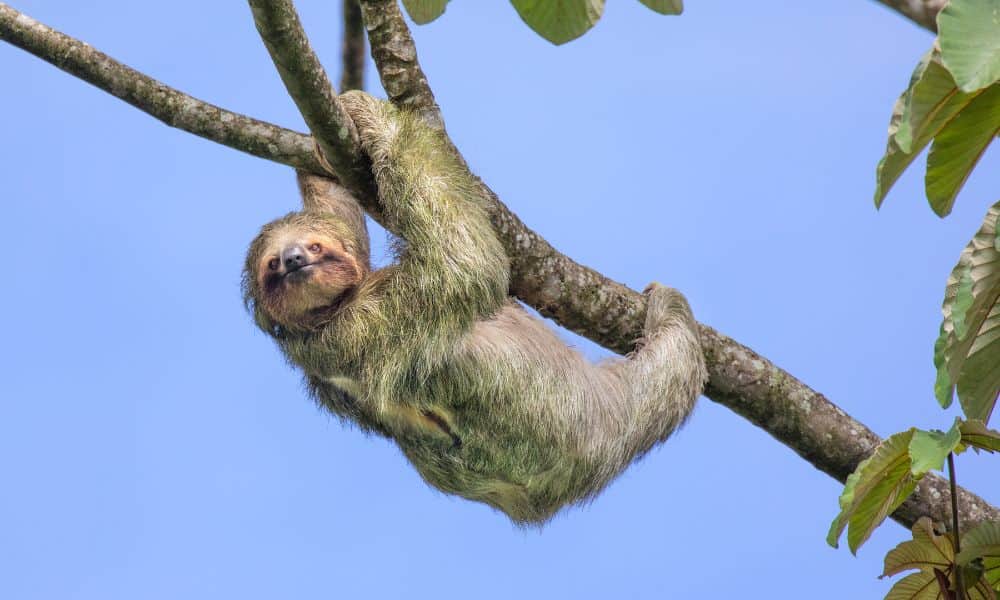
Sloths In Costa Rica: FAQ
Here are answers to a few frequently answered questions about Sloths.
How Many Hours Do Sloths Sleep?
Sloths, known for being among the sleepiest animals on the planet, sleep an average of 15 hours a day! Factors such as environmental conditions, age and health influence how much they sleep.
Both two-toed and three-toed sloths have a slow metabolism, and their diet primarily consists of leaves that are not very nutritious. As a result, sloths have adapted to conserve energy by sleeping for long periods and moving slowly when awake.
What Are Baby Sloths Called?
Sloth babies are simply called “baby sloths“. They spend much of their first year in very close contact with their mother.
What Country Are Sloths From?
Sloths are native to the tropical rainforests of Central and South America. People often associate them with Costa Rica, but they can also be found in various countries, including Panama, Nicaragua, Honduras, Belize, Colombia, Venezuela, Ecuador, Peru, and Brazil.
Are Sloths Dangerous?
Sloths are among the most gentle and docile animals on the planet. They are not known to have ever intentionally hurt a human being. That said, if an animal is hurt, feels threatened, or stressed, it may try to defend itself. You should always remain a respectful distance away from them.
If you find an injured sloth, do not attempt to pick it up. Instead, phone one of the wildlife rescue centres or wildlife sanctuaries, who will arrange a rescue.
What Are Sloths Predators?
Sloths have relatively few predators due to their slow movement and living high in trees. Big cats, birds of prey, large snakes and humans are considered predators mainly when sloths descend from trees.
How Long Do Sloths Live?
Sloths typically live for around 20 years in the wild. In captivity, they can live well into their 30’s with no predators and regular check-ups from the vet.
Final Thoughts: Where To See Sloths In Costa Rica
Costa Rica’s diverse landscapes offer many opportunities to see sloths in their natural habitat.
Whether you’re exploring national parks, wildlife sanctuaries, or cloud forests, the enchanting world of sloths awaits you.
Joining a guided sloth tour will greatly increase your chances of seeing sloths and we highly recommend you do this. Guides have a wealth of knowledge and can usually answer almost any question you care to ask. Bring your camera, patience, and a sense of wonder as you embark on this ultimate sloth-spotting adventure with your family.
